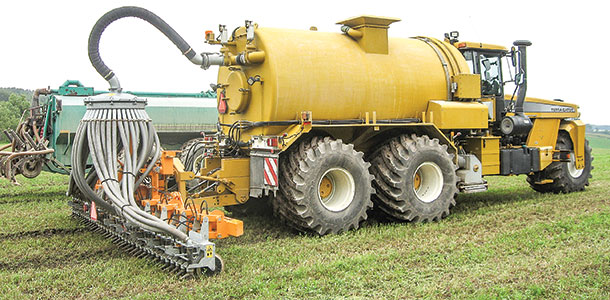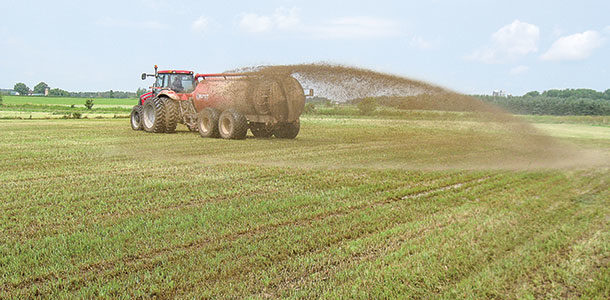Most dairy producers figure that since alfalfa and other legumes can capture nitrogen from the air, they shouldn’t apply manure.
Bill Jokela says that is not always the case. Jokela, USDA-Agricultural Research Service soil scientist with the U.S. Dairy Forage Research Center in Marshfield, Wisconsin, presented information at the 2014 World Dairy Expo explaining why.
Alfalfa has a high nutrient need, especially phosphorus, potassium and sulfur, and micronutrients such as boron. Manure is a good source of all these nutrients, he said.
For example, liquid dairy manure with 6 percent dry matter averages 23 pounds of nitrogen per 1,000 gallons, 8 pounds of P, 21 pounds of K and 2.3 pounds of sulfur based on long-term testing of manure from Wisconsin.
Jokela said that actual nutrient content can vary greatly. “Sample and analyze your manure,” he stressed.
Applying manure to alfalfa can increase yield, especially if the soil is nutrient-deficient. It also adds windows of time for application of manure on an operation and increases the acreage available for spreading manure.
And in situations where high rates of manure or fertilizer N have resulted in excess nitrate-nitrogen in the soil profile, deep-rooted alfalfa can take up nitrate, thus reducing the potential for nitrate leaching into groundwater.
Although alfalfa, soybeans and other legumes can use nitrogen from the air with the assistance of rhizobia bacteria that live in the nodules on their roots, the plant will take available nitrogen out of the soil first. This means legumes can help keep excess soil nitrogen in check and reduce the potential for nitrate leaching.

There are three general manure application strategies or times of application: pre-plant (apply before seeding alfalfa), top-dressing on established alfalfa and following last harvest at termination of the stand.
Jokela said applying manure pre-plant is an option that has shown good results. He cited studies that showed, in most cases, manure increased yields versus non-fertilized control in the seeding year and first production year.
Yields from manure were sometimes even greater than those from potassium and phosphorus commercial fertilizer, perhaps because of other manure nutrients (sulfur, micronutrients) or soil physical or microbial effects.
Pre-plant manure application will provide the most benefit on low-fertility soils, Jokela said. Operators can apply two to three years’ worth of potassium and phosphorous in one season but should avoid excess nitrogen. High salt and ammonia levels should also be avoided. Also, soil should be tilled or mixed thoroughly to avoid manure-seed contact.
If alfalfa is seeded with a nurse crop, chopping is preferred because the earlier harvest lessens the possibility of lodging that could damage the new alfalfa stand.
The advantages of top-dressing manure on established alfalfa stands of course include creating another window for application, and it may increase yield, but there are some challenges to consider. There is possible stand damage and yield loss from spreader traffic and manure coating the leaves. Application in late fall and winter can lead to runoff, and uneven application is a concern.
When assessing the value of top-dressing, keep in mind that established alfalfa stands do not require nitrogen, so there is no economic value gained from nitrogen in the manure.
Also, manure can carry pathogens, including salmonella, listeria and E. coli, and several protozoa that can affect human and animal health such as giardia and cryptosporidium. Some viruses can persist in manure for up to six months. “Apply no manure on hay or pastureground from diseased livestock,” he said.
To minimize these concerns, Jokela encouraged spreading manure as soon after harvesting a crop as possible. If the plants have more than a few days of regrowth, manure can coat leaves of the new growth and wheel traffic is more likely to break re-growing shoots and crack crowns, which may decrease yields.
He also recommends planting tolerant varieties, avoiding driving on wet soils, using smaller tractors and avoiding tractors with dual tires. “All pretty common-sense stuff,” he said.
Despite these challenges, results from several research studies have shown alfalfa yield increases from top-dressed liquid manure, especially where there is a nutrient need, he said. Sometimes there has been no yield effect or occasionally even a yield decrease. The yield effect depends on the balance between nutrient response and potential negative effects.
Surface broadcast is the most common manure application method, but there are alternatives, such as band application with or without an aerator and shallow injection. Potential benefits are more uniform spreading, less contamination of forage, less odor and reduced ammonia loss, of value especially for grass forages.
Application of manure to established grass forages has the additional benefit of supplying nitrogen since non-legume forages need nitrogen. Several studies with orchardgrass, tall fescue and reed canarygrass have shown yield increases of 100 to 200 percent from liquid manure, similar to yields from applying commercial nitrogen.
The third application strategy is to apply manure following the last harvest at termination of the legume or grass stand (before plowdown). This timing avoids any possible damage to the perennial forage crop. But, he said, it is important to limit application rates to the nitrogen need of the succeeding crop, accounting for both manure N and legume credit.
Apply to the fields with poorest stand and the least regrowth (least nitrogen credit), and apply immediately before tillage to minimize nutrient runoff potential. Jokela said to use the pre-side-dress soil nitrate test (PSNT) next year to assess the nitrogen needed if corn is the succeeding crop. FG
Kelli Kaderly-Boylen is a freelancer based in northeast Iowa.
PHOTOS
PHOTO 1: This image shows surface broadcast application, the most common method of applying manure.
PHOTO 2: Shallow injection application of manure could provide more uniform spreading, less contamination of forage, less odor and reduced ammonia loss, of value especially for grass forages. Photos courtesy of Bill Jokela, US Dairy Forage Research Center.










